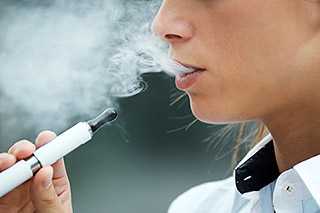E-cigarette study sparks national attention around e-cigarettes and nicotine toxicity

What is the problem?
One of the hottest topics in public health today is the use of electronic cigarettes (e-cigarettes), commonly referred to as “vaping.” These devices are often marketed as a safer alternative to conventional cigarettes, and represent a growing market share of tobacco products. But the health impact of these alternative products -- which typically use liquid nicotine (sometimes called “e-juice”) and a battery to create a vapor inhaled by the user -- is not clear.
Current e-cigarette use among middle and high school students tripled from 2013 to 2014 – from 4.5 percent to 13.4 percent, according to the National Youth Tobacco Survey (See http://www.cdc.gov/media/releases/2015/p0416-e-cigarette-use.html). Among U.S. adults, about one in five cigarette smokers have tried an electronic cigarette, according to a survey by CDC’s Office on Smoking and Health (OSH) released in 2013 (See http://www.cdc.gov/media/releases/2013/p0228_electronic_cigarettes.html.)
Given these trends in popularity, the public health community has raised questions about the safety of e-cigarettes and e-juice. Who is being exposed? How? Are these exposures leading to health effects?
What did CDC do?
To get a snapshot of whether any adverse health effects are associated with e-cigarette use, a team of scientists at the National Center on Environmental Health (NCEH) joined forces with OSH and the American Association of Poison Control Centers (AAPCC). The team analyzed call data on nicotine poisoning from the AAPCC’s National Poison Data System (NPDS), which collects data from poison centers around the country. They published their first set of findings in CDC’s Morbidity and Mortality Weekly Report (See http://www.cdc.gov/mmwr/preview/mmwrhtml/mm6313a4.htm?s_cid=mm6313a4_w). In April 2015, the team extended the time frame and updated their findings
Incorporating most recent data, the team found that:
- Annual e-cigarette calls increased from 238 in 2011 to 3,692 in 2014 – an increase of greater than 1400 percent.
- More than half (58%) of the calls to poison centers concerning e-cigarettes involved young children under the age of five.
- The analysis showed that e-cigarette calls were more likely than cigarette calls to include a report of an adverse health effect after exposure.
- The most common adverse health effects mentioned in calls related to e-cigarette were vomiting, nausea, and eye irritation.
The MMWR report captured significant media attention nationwide, resulting in close to 400 print and TV news stories, which had more than 203 million readers and viewers.
What was the public health impact?
According to the NPDS analysis, calls related to conventional cigarettes generally result from young children eating them. In contrast, poisoning related to e-cigarettes involves the e-juice and can occur in three ways: by ingestion, inhalation, or absorption through the skin or eyes. This is useful information to begin sharing with the public to help adults keep these products of the reach of children.
Developing strategies to monitor and prevent future poisonings is critical, especially as these products grow in popularity. Health-care providers; the public health community; e-cigarette manufacturers, distributors, sellers, and marketers; and the public should be aware that e-cigarettes have the potential to cause acute adverse health effects and represent an emerging public health concern.
Top of Page- Page last reviewed: May 28, 2015
- Page last updated: May 28, 2015
- Content source:


 ShareCompartir
ShareCompartir